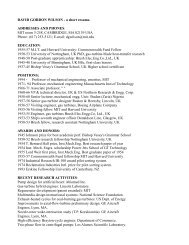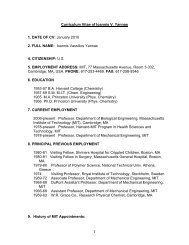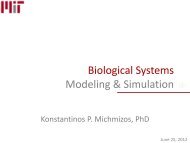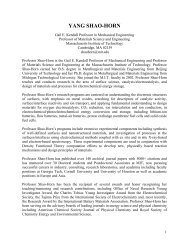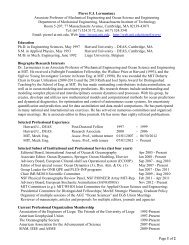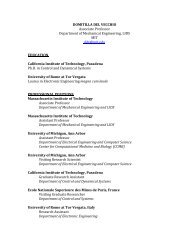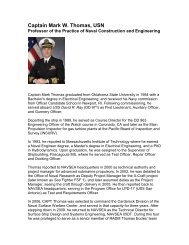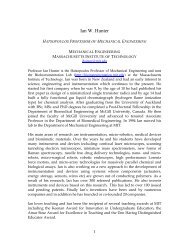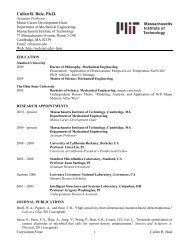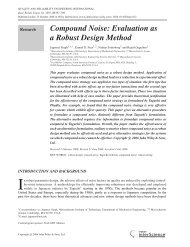Guide To Graduate Study In Mechanical Engineering - MIT
Guide To Graduate Study In Mechanical Engineering - MIT
Guide To Graduate Study In Mechanical Engineering - MIT
You also want an ePaper? Increase the reach of your titles
YUMPU automatically turns print PDFs into web optimized ePapers that Google loves.
• Business Fundamentals: Management for Engineers (2.891)<br />
• Plus 1 of the following: Product Design and Development (2.739J), Product<br />
Design (2.744); Precision Machine Design (2.75); Axiomatic Design (2.882);<br />
Assembly and Product Design (2.875J)<br />
2. Professional Seminar in Emerging Manufacturing <strong>In</strong>dustries<br />
3. Thesis Project (24 units) The thesis project is intended to give each student<br />
experience in a manufacturing industry, working on problems with both strategic<br />
breadth and technical depth. It is an integrating experience to help pull together the<br />
diverse topics treated in class. The projects will explore innovations in technology,<br />
systems and business strategy<br />
7. <strong>Mechanical</strong> Engineer's Degree<br />
The <strong>Mechanical</strong> Engineer's degree provides an opportunity for further study beyond the Master's<br />
level for those who wish to enter engineering practice rather than research. This degree<br />
emphasizes breadth of knowledge in mechanical engineering and its economic and social<br />
implications, and is quite distinct from the PhD, which emphasizes depth and originality of<br />
research. The <strong>Mechanical</strong> Engineer's degree is not a stepping stone toward the PhD.<br />
The Engineer's degree has four requirements: (1) writing ability, (2) a program of<br />
coursework, (3) thesis, and (4) a qualifying examination. These are described below.<br />
Program of courses. The subject requirements are as follows:<br />
(1) 162 credit units (including credited units taken during the Master's degree program).<br />
(2) At least 120 units (including 2.999 - see below) must be graduate H-level subjects.<br />
(3) At least one subject from eight of the following ten areas:<br />
a. Mechanics of Solids f. Design<br />
b. Materials g. Manufacturing<br />
c . Fluid Mechanics h. Nanotechnology<br />
d. Thermodynamics/Heat transfer i. Energy<br />
e. System Dynamics & Control h. Bioenegineering<br />
(4) A management/economics requirement of one subject as approved by the Engineer's Degree<br />
Subcommittee.<br />
Students entering the <strong>Graduate</strong> School with a Master's degree are permitted to transfer no<br />
more than 24 units from another school to the <strong>MIT</strong> record. No thesis units may be transferred.<br />
Subjects being transferred to <strong>MIT</strong> records should have a grade of B or higher.<br />
Thesis. The thesis may be an extension of a suitable applications-oriented<br />
SMME/SOME/SMNAME/SMOGE thesis, or it may be a separate piece of work. An important<br />
requirement is that the thesis deal with the solution of real, practical engineering problems,<br />
including both their technical and socio-economic aspects. Students are required to submit a<br />
specific thesis proposal to the Engineer's Degree Subcommittee shortly after embarking on the<br />
program. Students who enter the program with an SM degree from another school must do a<br />
separate Engineer's thesis.<br />
Students who do a separate Engineer's thesis, or who are required to extend a previously<br />
submitted <strong>MIT</strong> SMME/SOME/SMNAME/SMOGE thesis, may receive up to a maximum of 12<br />
8



